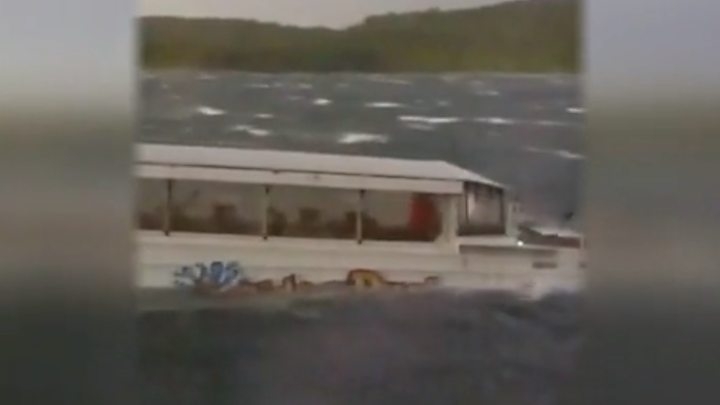Nine US tour boat victims from same family

Nine of the 17 people who died when a tour boat sank in a Missouri lake on Thursday were from the same family, according to the state's governor.
Governor Michael Parson said that he spoke to a woman who "lost nine of the 11 members of her family".
The woman said the boat's captain had told passengers not to put on life jackets, US media report.
The "duck boat" was carrying 31 people when it overturned on Table Rock Lake, a popular tourist attraction.
Missouri Highway Patrol said the ages of the deceased range from one to 70.
The woman who says she lost nine members of her family has been named as Tia Coleman, Fox59 News reports.
"I lost all my children, I lost my husband, I lost my mother-in-law, I lost my father-in-law, I lost my uncle, I lost my sister-in-law - she was my sister - and I lost my nephew, I'm OK, but this is really hard," she told the TV news station.
"The captain told us 'Don't worry about grabbing the life jackets, you won't need them,' so nobody grabbed them because we listened to the captain and he told us to stay seated.
"However in doing that, when it was time to grab them it was too late. I believe that a lot of people could have been spared."
The captain was among those who survived. He is now in a hospital.
How did the accident unfold?
The vessel began taking on water shortly before 19:00 (00:00 GMT) on Thursday.
Video footage shot by a witness on shore showed two duck boats struggling through choppy waters and spray.
One of the boats made it to shore but the other was driven back by the wind and eventually overwhelmed.
During a press conference on Friday, Sheriff Doug Rader could not say whether passengers were wearing life vests at the time of the capsizing, or if the boat's windows were open.
Missouri law requires all children under the age of seven to wear life jackets on boats, unless they are in the "cabin area".
The vessel sank in 40ft (12m) of water before plunging to a final depth of 80ft.
Sheriff Rader said divers have located the sunken boat and will try to recover it.
'Shouldn't have been in the water'
Jim Pattison Jr, the tour boat company owner, said the storm appeared to have taken people in the area by surprise.
The boat, he told US media, "shouldn't have been in the water" due to the weather.
Mr Pattinson said that he has been told by his employees that the accident was likely caused by "a fast-moving storm that came out of basically nowhere".
"Usually the lake is very placid and it's not a long tour, they go in and kind of around an island and back. We had other boats in the water earlier and it had been a great, sort of calm experience," he said.
The company had been operating for 47 years without incident, Mr Pattinson told CBS, adding that the captain had over 16 years of experience on the water.
He also said that the boat had life jackets onboard, but added that under Missouri law, passengers are not required to wear them.
The deadly accident happened as a line of powerful thunderstorms rolled through the American Midwest, uprooting trees and felling power lines.
At the time of the accident, winds reached around 65mph (104 km/h), according to the National Weather Service.
Are duck boats dangerous?
There are hundreds of so-called duck boats in use around the world. The amphibious vehicles are popular with tourists and have been providing tours for decades.
The most serious incident was in 1999, when a duck boat listed and sank just minutes after entering Lake Hamilton in Arkansas.
Thirteen people were killed, including three children, after they became trapped beneath the vehicle's canopy.
The cause was later reported to be "uncontrolled flooding" due to a loose part.
What is a duck boat?
The sightseeing vehicles are based on a design used during World War Two to transport personnel and supplies over land and water - known as the DUKW.
The DUKW, a six-wheel-drive amphibious truck, was first made in the US in the mid-1940s to deliver people and materials ashore where no port facilities existed.
Some 21,000 DUKWs were produced for use during World War Two. Many served on D-Day and in the Normandy landings.
